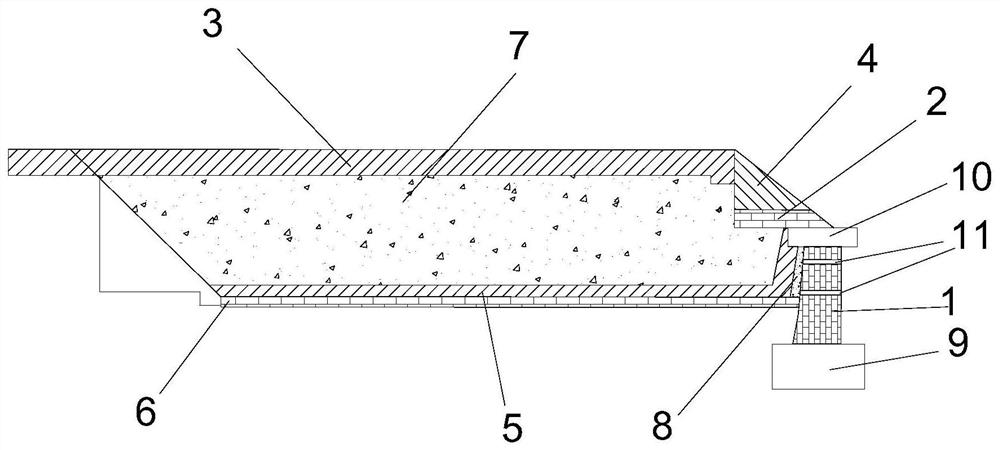Modified phosphogypsum and its preparation method
A phosphogypsum and modification technology, applied in the field of phosphogypsum, can solve problems such as low utilization rate, groundwater pollution, impurity cracking, etc.
- Summary
- Abstract
- Description
- Claims
- Application Information
AI Technical Summary
Problems solved by technology
Method used
Image
Examples
Embodiment 1
[0041] Modified phosphogypsum, including CaSO 4 and CaCO 3 ; where CaSO 4 The mass percentage content is 84%, CaCO 3 The mass percentage content is 15%, and the remaining components are 1%; and the modified phosphogypsum is also added with clay with a mass percentage content of 30%.
[0042] The modified phosphogypsum is prepared by the following method, comprising the following steps:
[0043] S1. Add CaCO to phosphogypsum 3 , and make CaCO 3 The mass percentage content is the final CaCO 3 1 / 2 of the mass percentage content; stirring makes phosphogypsum and CaCO 3 well mixed;
[0044] S2, dehydrate the phosphogypsum, and the dehydration temperature is 150°C;
[0045] S3, stirring and crushing the phosphogypsum to powder;
[0046] S4, and then to the mixed phosphogypsum and CaCO 3 Add CaCO 3 ; and make CaCO 3 The mass percentage content is 15%; stir and mix evenly;
[0047] S5, in step S4, phosphogypsum and CaCO 3 After mixing uniformly, clay was added to the mi...
Embodiment 2
[0049] Modified phosphogypsum, including CaSO 4 and CaCO 3 ; where CaSO 4 The mass percentage content is 94%, CaCO 3The mass percentage content is 4%, and the remaining components are 1%; and clay with a mass percentage content of 50% is added to the modified phosphogypsum.
[0050] The system of described modified phosphogypsum comprises the following steps:
[0051] S1, adding CaCO to phosphogypsum 3 , and makes CaCO 3 The mass percentage content is the final CaCO 3 One-half of the mass percentage content; stirring makes phosphogypsum and CaCO 3 well mixed;
[0052] S2, dehydrating the phosphogypsum, the dehydration temperature is 180°C;
[0053] S3, stirring and crushing the phosphogypsum into powder;
[0054] S4, then to the mixed phosphogypsum and CaCO 3 CaCO 3 ; and make CaCO 3 The mass percentage content is 5%; stir and mix evenly;
[0055] S5, in step S4, phosphogypsum and CaCO 3 After mixing evenly, clay is added to the mixture so that the mass percenta...
Embodiment 3
[0057] Modified phosphogypsum, including CaSO 4 and CaCO 3 ; where CaSO 4 The mass percentage content is 89%, CaCO 3 The mass percentage content is 10%, and the remaining components are 1%; and clay with a mass percentage content of 80% is added to the modified phosphogypsum.
[0058] The system of described modified phosphogypsum comprises the following steps:
[0059] S1, adding CaCO to phosphogypsum 3 , and makes CaCO 3 The mass percentage content is the final CaCO 3 One-half of the mass percentage content; stirring makes phosphogypsum and CaCO 3 well mixed;
[0060] S2, dehydrating the phosphogypsum, the dehydration temperature is 200°C;
[0061] S3, stirring and crushing the phosphogypsum into powder;
[0062] S4, then to the mixed phosphogypsum and CaCO 3 CaCO 3 ; and make CaCO 3 The mass percentage content is 10%; stir and mix evenly;
[0063] S5, in step S4, phosphogypsum and CaCO 3 After mixing evenly, clay is added to the mixture so that the mass perce...
PUM
 Login to View More
Login to View More Abstract
Description
Claims
Application Information
 Login to View More
Login to View More - R&D
- Intellectual Property
- Life Sciences
- Materials
- Tech Scout
- Unparalleled Data Quality
- Higher Quality Content
- 60% Fewer Hallucinations
Browse by: Latest US Patents, China's latest patents, Technical Efficacy Thesaurus, Application Domain, Technology Topic, Popular Technical Reports.
© 2025 PatSnap. All rights reserved.Legal|Privacy policy|Modern Slavery Act Transparency Statement|Sitemap|About US| Contact US: help@patsnap.com

